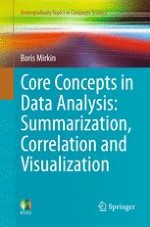2011 | OriginalPaper | Chapter
6. K-Means and Related Clustering Methods
Author : Boris Mirkin
Published in: Core Concepts in Data Analysis: Summarization, Correlation and Visualization
Publisher: Springer London
Activate our intelligent search to find suitable subject content or patents.
Select sections of text to find matching patents with Artificial Intelligence. powered by
Select sections of text to find additional relevant content using AI-assisted search. powered by
